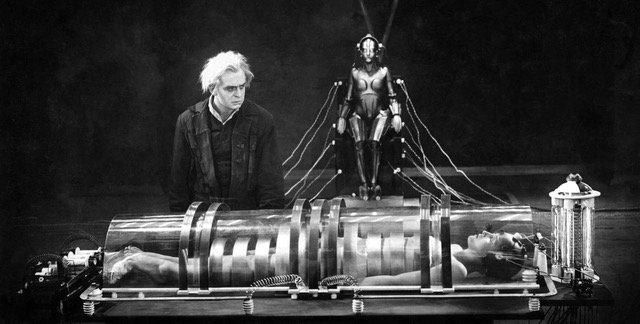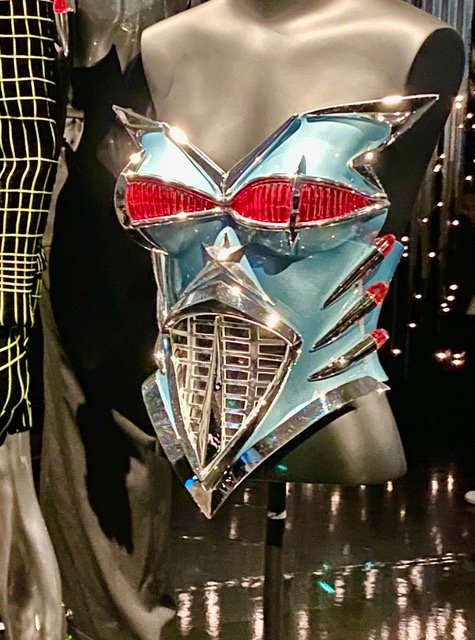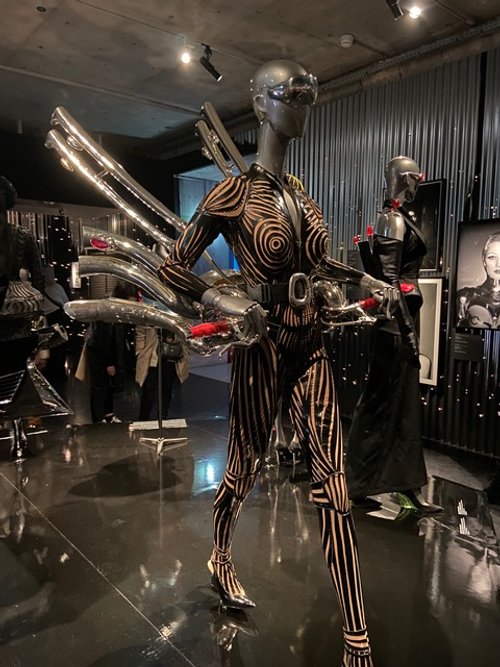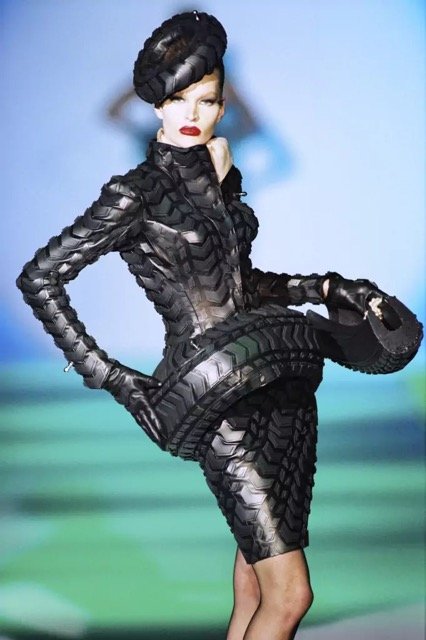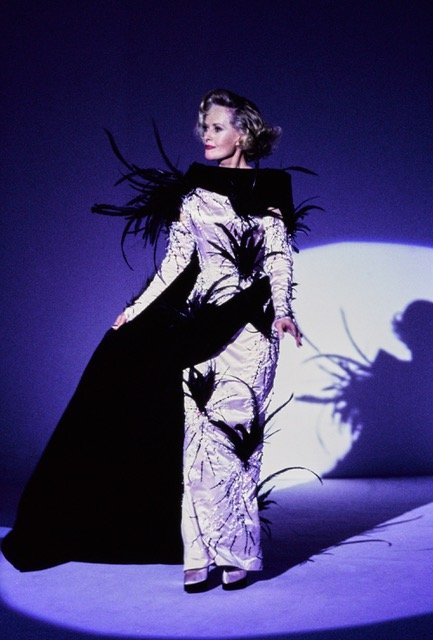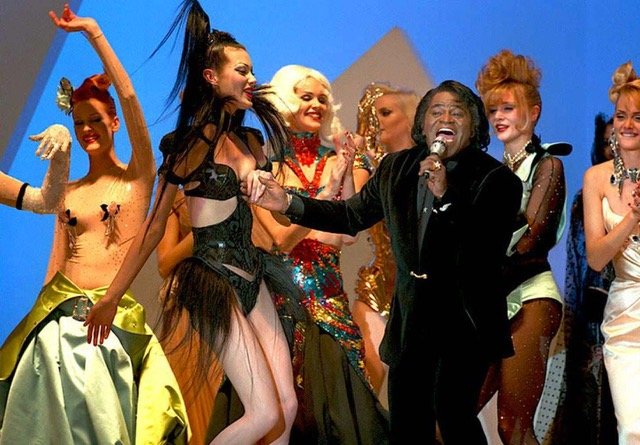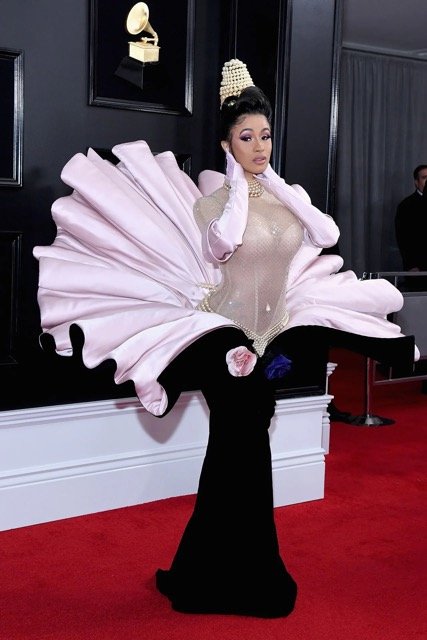Extreme Fashion: Or the appeal of being Muglerized
Thierry Mugler Couturissime, Musée des Arts Décoratifs
Thierry Mugler appeared on Le Quotidian for a long conversation with the show’s host, Yann Barthes. Which encouraged me to check out the retrospective of his career at the Musée des Arts Décoratifs (til April 24). Oh, by the way, it isn’t Thierry Mugler anymore. It’s Manfred. He said it was a way to distance himself from his former life. Or maybe when he left Clarins in 2002, (the conglomerate bought his label in 1997), he no longer owned his name. Like the singer Prince, during his feud with Warner Brothers, who changed his name to The Artist Formerly Known as Prince.
I had a difficult time concentrating on what Mugler was saying during the interview because I was mesmerized by how he looked. (Figure 1) He was wearing a hooded gold puff jacket opened to the waist. With nothing on underneath, except for a gold chain around his thick neck. Maybe I shouldn’t have been shocked. But one doesn’t often (ever) see a 73 year old man on television with a bare chest. What an ageist I have become in my old age!
Figure 1. Manfred Mugler on Le Quotidien, October 2021
Mugler’s voice was very deep. His face was very big. His jaw was very square. His body was like a cartoon. Wide shoulders, Huge pecs. Muscled, flat stomach. He looked like Arnold Schwarzenegger back in the day.
Yann Barthes asked Manfred about his transformation. He explained that his nose had been completely destroyed by an accident in the gym. And that he had injured his hip in a car accident. With hip surgery looming, he decided to take the opportunity offered by general anesthesia to rebuild his face.
I wanted to know more. Here’s a description of Manfred from the New York Times from 2010, 8 years after he had walked away from his own label. “During that time (2002-2010) wrote Eric Wilson, “(Mugler) has designed stage costumes for erotic circus performers, taken to calling himself Manfred and transformed his body with an extreme regimen of diet, exercise and what is apparently plastic surgery.” To become, according to Wilson, “a 240-pound spectacle of muscle and nipple and tattoo.” No, I couldn’t see his nipples on TV. Yes, there are photos. (Figures 2, 3)
Figure 2. Manfred Thierry Mugler, Steven Klein photographer, 2019
Figure 3. Manfred Thierry Mugler, Steven Klein photographer, 2019
Wilson seemed as disturbed as I was, so I kept looking to see if Manfred had spoken about his transformation with anyone else. I found an interview from 2019 with a friend of his, the actress Tippi Hedren. Here is, in part, what he said. Wanting to make the surgery on his hip ‘more fun,’ he asked the surgeon to take a piece of bone from his hip and put it on his chin. “I wanted my face to represent progress, because after years of being a thin, charming dancer, I wanted to be a warrior. … I’m a superhero, so it’s normal to have the face of one.” (Figure 4)
Figure 4. Thierry Mugler with models following his fall/winter 1999/2000
Figure 4a. Thierry Mugler, photo, 1990s
Mugler insisted on distinguishing plastic surgery which he said was artificial with his surgery, which he said was natural. Because he used his own bone and not plastic or silicon. It seems odd that using natural material was so important to him. I mean, he is the designer who introduced rubber and latex and vinyl to haute couture.
Okay, the changes to his face were the result of cosmetic surgery. That I get. But his body? Can a man, even one who has been a dancer, transform himself in his mid-50s into a cartoon superhero? And maintain that physique for 20 years. That’s a lot of hours in the gym.
Yann Barthes said to Manfred at the end of the interview. “Your body has become your project. You have Muglerized yourself.” Manfred smiled and agreed.
Mugler was born in Strasbourg in 1948. His dual passions were dancing and drawing. He began studying classical dance at the age of 9. And he continued drawing. At 14, he entered the corps de ballet for the Opéra National du Rhin and he began studying interior design at the Haute École des Arts du Rhin, both in Strasbourg.
When Strasbourg became too provincial for him, he moved to Paris, planning to audition for contemporary dance companies. But when he discovered that his drawings could earn him more money than his dancing, he switched from free lance dancing to free lance designing and began working for pret-a-porter lines like Cacharel and Dorothée Bis. I know those two brands, they were the ones for which the model turned photographer Sarah Moon first worked. Her soft, fuzzy photographs suited the clothes perfectly. Flower child clothes, hippie clothes. Not Mugler clothes.
In 1973, at the age of 25, he presented his first collection. Three years later, he opened his first boutique. In 1992, the 44 year old designer introduced a couture line and a perfume, Angel.
By 1997, Mugler was ready to quit. “Fashion was … about marketing and branding …” he said. “I thought it was time put down my tools and go back to my original passion in life, which was staging.” So, he sold his company to the cosmetic conglomerate, Clarins but stuck around. The partnership was contentious. In 2002, he left. To work on projects that pleased him with people who appreciated him.
The exhibition at the Musée des Arts Décoratifs, Thierry Mugler, Couturissime, is the final venue for this 4 city (Montreal, Rotterdam, Munich) extravaganza, conceived and created by curators at the Montreal Museum of Fine Arts in 2019.
Museums had proposed retrospectives to Mugler before but he hadn’t been interested. Those other proposals wanted to stick to chronology which didn’t interest him at all. The director of the Montreal Museum had a different vision. Her proposal was “more like a promenade, or an opera, with a rhythm and different mood in each room,” Mugler said. “Something more fun.” When he agreed, the museum brought in theatre set designers and a special effects company to work on it.
At the Musée des Arts Décoratifs, the exhibition is spread over two floors and divided into acts. The opening act is an aquatic one. After last week’s icebergs at Le Bon Marché, I felt right at home with the burbling sounds of water and the videos on the walls of schools of fish swimming by at eye level. (Figure 5) And there were the gowns.
Figure 5. Thierry Mugler, Courissime, Musée des Arts Décoratifs
Mugler’s designs exaggerate the female form - wide shoulders, tiny waists, full hips, round bottoms. Perfect hourglass shapes. Costumes that may start with the body of the model but which Mugler ‘Muglerized’ to achieve the look he sought.
Yann Barthes asked Manfred about his inspiration. Without hesitation, he answered, ballerinas. Their fragility and grace; discipline and strength; courage and emotion. He shared their devotion to beauty even if his definition of beauty was quite different from their body types. To him, women are sex subjects, not sex objects.
Following the sea fantasy were Mugler’s “Insects" and “Chimère”, collections. Fun bug hats and mask wearing spider web costumes. (Figures 6, 7) The mask hiding the face, the web revealing everything else. The Chimera dress (Figure 8) takes center stage in this act. Celebrated as one of the most expensive haute couture gowns in fashion history. The long gown shimmers with iridescent scales, green with red accents then gradually purple at the bottom. A rib articulated gold breast plate, sleeves that hang almost to the floor and a scaled helmet headdress. The craftspeople who painstakingly made it, took hundreds of hours to complete it.
Figure 6. Insect Costume, Thierry Mugler
Figure 7. Spider Dress, Thierry Mugler
Figure 8. Chimera Dress, Thierry Mugler
The Science Fiction and Automobile collections takes fantasy to another whole level. Calling upon the expertise of an aircraft bodywork specialist and an industrial designer, Mugler created robot costumes (Figure 9) that were reminiscent of the Maschinen mensch (machine-human) from Fritz Lang’s film ‘Metropolis’. (Figure 10) For Automobiles, the references are both futuristic and classic. Costumes with “convertible” sleeves, “bumper” bustiers and “radiator” belts. (Figure 11) One mannequin was dressed entirely in black rubber tires, from her jacket and skirt to her hat and purse. (Figures 12)
9. Robot outfit, Thierry Mugler
10. Metropolis, Fritz Lang 1927
11. Classic Car outfit, Thierry Mugler
11a. Classic Car outfit, Thierry Mugler
Figure 12. Tire outfit, Thierry Mugler
Figure 12a. Tire Outfit, Thierry Mugler
At an exhibition on Chanel, I had learned about Coco Chanel’s development of her iconic Number 5 perfume. So I was interested to learn what Mugler’s process had been in creating his signature fragrance, Angel. (Figures 13, 14) Mugler’s idea for a scent was something no one had ever imagined before. Here is how he put it: “I want something mouth-watering and tasty, which reminds of my childhood…(T)he scent of a fairground, candy floss, little cakes, chocolates, caramels and things like that.” According to the exhibition’s curator, Mugler “wanted those who smelled the perfume to want ‘to bite the wearer, like they were edible.’” Michael Edwards, a fragrance historian called Mugler’s imagination transformative for perfumery. His perfume was a complete departure from perfumes of the past and a harbinger of perfumes to come. Expanding the definition of perfume. Making Gourmand a perfume category.
Figure 13. Bottle of Angel Perfume
Figure 14. Jerry Hall with bottle of Angel perfume
Mugler’s other ‘firsts’ included using materials like latex and rubber and vinyl, well known in kinkier contexts, but Mugler took them out of the porn industry and into the fashion industry.
He was also among the first fashion designers to have actresses and singers walking in his shows. Dianna Ross (Figure 15) and David Bowie; Tippi Hedren (Figure 16) and Sharon Stone (joined icons from the fashion world like Jerry Hall (the face of Angel Perfume and one time wife of Mick Jagger) and Iman (David Bowie’s wife) on the catwalk.
Figure 15. Diana Ross and Thierry Marks
Figure 16. Tippi Hedren in ‘The Birds’ dress, Thierry Mugler
Mugler perfectionism included photographing his collections. Of course. And some of the iconic photos taken by photographers who worked with him are here.
One space is dedicated to Mugler’s collaboration with Helmut Newton. Mugler said “Helmut’s work was exactly my vision, my twin”. Eventually Mugler started doing it all - organizing his own photo shoots, taking his own photographs. He set up shoots and photographed models on glaciers and icebergs in Greenland, (Figure 17) on the desert of the Sahara, on iconic buildings in Paris and New York City. (Figure 18)
Figure 17. Model in Greenland, Gown & Photograph by Thierry Mugler
Figure 18. Model on Chrysler Building, New York, Outfit & Photograph, Thierry Mugler, 1988
And then there was a very sober, collarless jacket on display. (Figure 19) The former French Culture Minister Jack Lang had worn it to a 1985 meeting of the National Assembly. The politicians were scandalized. How dare Lang show up dressed like that. Where was his shirt, where was his tie? He was booed by his fellow politicians. Didn’t bother him a bit.
Figure 19. Jacket worn by Jack Lang, designed by Thierry Mugler, 1985
The music video for George Michael’s. “Too Funky,” which Mugler directed in 1991 was on a constant loop. Everybody who was anybody was in the video and quite a few nobodies who were somebody to Mugler were in it, too. Among the top models was Linda Evangelista (Figure 20) (who hasn’t been seen in public for 5 years because of a failed cosmetic procedure which was supposed to take fat away but instead did the opposite) and Julie Newmar, the original Catwoman, an obvious choice for Mugler.
Figure 20. Linda Evangelista in “Too Funky” 1991
Figure 20a. Linda Evangelista in “Too Funky” Dress, 1991
Another video on a loop was Mugler’s 1995 Fall Haute Couture Collection show in Paris. Heralded the “Woodstock of Fashion,” it celebrated the 20th anniversary of the Mugler label. James Brown sang (Figure 21) and Tippi Hedren walked in a dress covered with birds, (see Figure 16 above) a reference to Hitchcock’s film, The Birds.
Figure 21. Fall Haute Couture Collection, 1995, Paris .Thierry Mugler, with James Brown
The final room is a hologram reconstruction of snippets of the theatrical production of Macbeth presented by the Comédie-Française in 1985 for which Mugler designed the costumes. There is a scene of the three witches and another of a raving Lady Macbeth. One reviewer wrote that Mugler’s costumes were BDSM-meets-Renaissance Venice. I had to google BDSM. For those of you as clueless as I am, it means Bondage, Discipline, Dominance and Submission. According to Mugler, the costumes cost a fortune and “caused a scandal”. No surprise on either count.
Here are a few things that Mugler did after he left his label in 2002. He had already designed costumes for Madonna and Michael Jackson tours and the dress Demi Moore wore in the 1993 film Indecent Proposal. (Figure 22) So, he was a natural for Beyonce’s year long “I am …” world tour, for which he was the artistic director. He designed 58 outfits for her (Figure 23) and outfits for her musicians, dancers and choristers in addition to overseeing the lighting and choreography.
Figure 22. Dress worn by Demi Moore in film, “Indecent Proposal, designed by Thierry Mugler
Figure 23. Beyonce “I Am….” World Tour, 2009 - 2010, Custumes designed by Thierry Mugler
More recently, he began working with two women whose manipulation of their own bodies made them perfect choices for Mugler’s magic. For the 2019 Grammys, the singer Cardi B wore three vintage Mugler gowns including the 1995 Venus gown. (Figure 24) A long black mermaid shaped velvet gown that opens at the hips to reveal an undulating pink interior. Cardi B seems to grow directly out of the dress, wearing a sparkling, skin color body suit. With long pink gloves and pearls around her hips, neck and headpiece in the shape of a gramophone, she is as one with that dress.
Figure 24. Cardi-B at Grammys 2019 in Venus Gown, original design1995 by Thierry Mugler
That same year, he designed a new dress for Kim Kardashian for the Met Gala. (Figure 25) A dress into which she seemed virtually poured. She was meant to look wet and she did. The conceit included tiny crystals all over the dress that looked like drops of water. The color was Kim flesh tone. It accentuated her wide hips and tiny waist while channeling Sophia Loren in the 1957 film, ‘Boy on a Dolphin’.(Figure 26)
Figure 25. Kim Kardashian at Met Gala 2019 in original Thierry Mugler gown
Figure 26. Sophia Loren in film: Boy on a Dolphin, 1957
At the end of the interview, Barthes asked Manfred what he thought of the exhibition. He replied, “I couldn’t believe I had done all that.” (Figure 27)
Figure 27. Photograph of Thierry Mugler at exhibition of his designs. (In gold jacket with tee shirt underneath)
A few months later, at the end of January, Manfred was dead. Of natural causes. At age 73. I am glad he had a chance to see this exhibition before he died. His death prompted me to see the exhibit. I hope this review prompts you to see it, too.
Copyright © 2022 Beverly Held, Ph.D. All rights reserved
Dear Reader, I hope you enjoyed reading this article. Please click here or sign up below to receive more articles plus other original content from me, Dr. B. Merci!
And, if you enjoyed reading this review, please consider writing a comment. Thank you.











